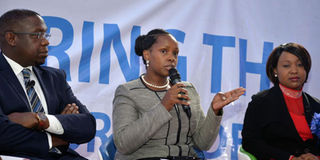Gender equality heralds economic gains

From left: Nairobi Securities Exchange (NSE) chief executive officer Geoffrey Odundo, East African Breweries group legal director Wambui Kosgey and Techno Brain Group's global director of human resources Sarah Richson at an event on gender equality to commemorate the International Women’s Day at the NSE on March 3, 2016. PHOTO | SALATON NJAU | NATION MEDIA GROUP
What you need to know:
- Awareness of the immense economic benefits of tackling gender inequality is increasing.
Narrowing the global gender gap would have huge potential economic benefits. According to the McKinsey Global Institute (MGI), if every government helped its citizens to catch up to the country in its region that has made the fastest strides toward gender parity, the total annual payoff in additional gross domestic product (GDP) could reach $12 trillion in 2025.
Gender parity is also a moral imperative, recognised in the United Nations’ Sustainable Development Goals (SDGs). Together with the aggregate economic payoff, investing in women and girls would transform millions of lives for the better.
The question, then, is how to realise these enormous gains. Achieving economic gender equality is not possible without working toward social gender equality. An important part of the answer, it turns out, lies in improving access to essential services such as education and family planning.
MGI estimates that the additional annual investment required to deliver essential services to those who need them is between $1.5-2 trillion in 2025. This compares with estimated spending of $6.3 trillion on these services in 2014. In other words, the potential economic payoff in 2025 would be 6-8 times the spending required.
In six areas—education, family planning, maternal health, financial inclusion, digital inclusion, and assistance with unpaid care work—improved access to services could unlock women’s economic potential and help to meet the SDGs’ gender-equality targets. Assistance with unpaid care work represents one of the biggest opportunities for improvement worldwide, but there is broad scope for improvement in financial and digital inclusion in South Asia, and sub-Saharan Africa is greatly in need of advances in maternal health.
In order to meet the path set by the SDGs, 58 million more girls and 60 million more boys will need to be enrolled in schools. Some 224 million more women will need to gain access to formal financial services to close the gender gap completely. And roughly 445 million people will need improved access to safe water supplies.
This ambitious agenda will not be delivered effectively without action from governments working in concert with the private sector and non-governmental organisations. It will require additional investment, the creation of job opportunities for women, and the introduction of measures to help women move into more productive work.
Measures proven to improve access to education include building more secondary schools, ensuring that girls are provided with sanitation facilities in the places where they study, and creating financial incentives to raise enrolment and keep girls in school.
When it comes to family planning and maternal health, the main priorities are to expand the number of health workers and develop emergency services and maternal health services in rural areas. One of the most effective ways to reduce the amount of time women spend on unpaid care work is expanding the provision of childcare. Digital technologies can help more women gain access to financial services, but only if countries expand their infrastructure and help enhance women’s digital and financial literacy.
These measures can be funded from the additional funds from taxes on the incremental GDP growth that empowering women will deliver. In places where such tax revenues may not be sufficient, private investment can be attracted. Legislation enacted this year by New York State, for example, requires that employers and employees each contribute funds to finance family leave.
However, policy changes will be insufficient if attitudes prevent people from making use of new rights and services. Even in Sweden, where gender equality is advanced, studies suggest that roughly 33 per cent of men take parental leave, compared to more than 75 per cent of women. To be sure, participation in paid work or domestic work is ultimately a matter of personal choice, but social attitudes may need to be addressed if they hinder true freedom to decide.
There are grounds for optimism. Many developing countries are now at a tipping point, with sharply narrowing gender gaps in education, implying huge potential gains in women’s economic prospects. And the rapid spread of digital technologies is improving access to finance and work opportunities in completely new ways.
Awareness of the immense economic benefits of tackling gender inequality is increasing. We have a $12 trillion incentive to accelerate progress.
Rakesh Mohan is a former deputy governor of the Reserve Bank of India and a senior fellow at the Jackson Institute for Global Affairs at Yale University in the US and distinguished fellow at Brookings India. Ms Madgavkar is a McKinsey Global Institute partner.
Copyright: Project Syndicate, 2016.Awareness of the immense economic benefits of tackling gender inequality is increasing.




